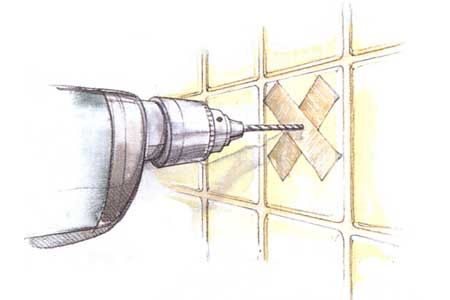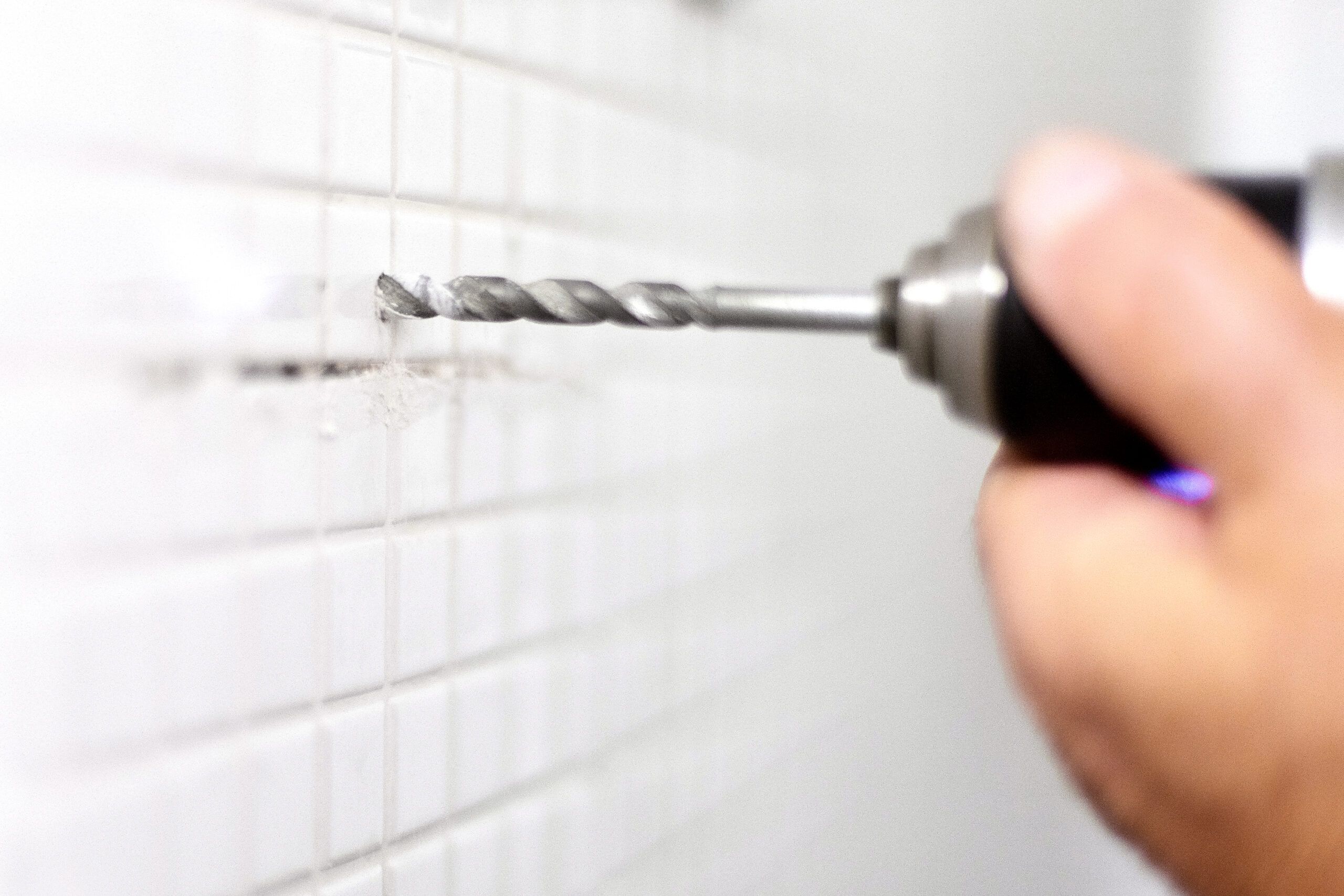Putting holes in tiled walls is a common when working on your bathroom. Almost anything that mounts to the wall—from installing hardware for toilet paper rolls and soap dishes to a new medicine cabinet—will require drilling through tile. While this may seem daunting, you can complete the project with the right tools and techniques. This guide will walk you through the process step-by-step.
Types of Tile
Before you start drilling, you should know which type of tile you’re working with. Below are the three most common types, with a little more on their specific properties.
- Ceramic: Ceramic is very common in both old and new homes. Because of its softer composition, it’s relatively easy to drill through compared to other tile types, but you still need to use the proper technique to prevent cracks.
- Glass: Glass tile is the most delicate of the three types and requires extra caution when drilling due to a high chipping and cracking risk. You’ll need special bits and techniques to create clean holes.
- Porcelain: Porcelain is made from finer clay fired at higher temperatures, resulting in a more durable and less porous surface. Its hardness can make it challenging to get through without the right equipment.
Essential Tools for Drilling Tile
Having the right tools is crucial for successfully drilling through tile without causing damage. Here’s what you need.
Drill Bits for Tile
The type of drill bit you use is the most critical factor in drilling the tile successfully. For ceramic tile, a carbide-tipped masonry bit is usually sufficient. These bits are designed to withstand the hardness of tile and can create clean holes without excessive wear.
We recommend buying a diamond-tipped bit for porcelain and glass tiles or when you’re in doubt about which type of tile you have. These are more expensive, but they can effectively drill through even the hardest tiles.
Other Necessary Equipment
In addition to the right drill bits, you’ll need these tools:
- Power drill (corded or cordless)
- Level (for ensuring straight lines when installing multiple fixtures)
- Masking tape
- Pencil or marker for marking drill points
- Safety glasses and a dust mask
- Spray bottle with water (for cooling the bit when drilling glass or porcelain)
Safety Precautions When Drilling Tile
Safety should always be your top priority when working with power tools and tiles.
Protective Gear
Safety glasses and work gloves protect your eyes and hands from tile chips and sharp edges. You should also put on a dust mask before you start drilling. Drilling through ceramic may release silica dust that can cause chronic respiratory problems if inhaled over a threshold.
Dust Management
Drilling tile can create a significant amount of dust. To manage this, work in a ventilated area and have a vacuum ready to clean up dust immediately after drilling. You can also control dust using a water spray during the drilling process.
The Drilling Process for Tile
Proper preparation is key to achieving clean, accurate holes in your tile. Set up your workspace and mark your drilling points carefully. Then, follow the right drilling techniques.
Measuring and Marking
Measure at least three times before marking your drill points to confirm you’re placing holes in the right spots. If you’re installing a fixture with multiple mounting points, such as a towel bar, use a level to align everything perfectly. It’s generally best to locate hardware near the center of tiles, as edges are more prone to cracking.
Applying Masking Tape
Before drilling, apply a piece of masking tape over the area. This creates additional tension and helps prevent the drill bit from slipping. Remember to mark the tape where you’ll be drilling.

Drilling Through the Tile
Fill a spray bottle with water if you’re drilling through porcelain or glass. As you go, spray the water on the drill bit and tile, helping you control dust, avoid overheating, and reduce the risk of cracks.
Align the bit with your marking, and start drilling slowly with light pressure. Remember, patience is key, and rushing the process can lead to cracked tiles and inaccurate holes.
Once the hole is started, gradually increase speed and pressure, but don’t go full speed. Medium speed with steady pressure will do the job without overheating your drill. Keep spraying water on the area.
When you feel the bit break through the back of the tile, ease off the pressure. You can now speed up your drill to extend the hole into the drywall or backer board with minimal damage.
How to Drill Large Holes in Tile
Sometimes, you need to make larger holes in tile to install plumbing fixtures. It’s fastest to use a hole saw for this. If you don’t have one, you can also drill enough smaller holes around the area’s perimeter to “cut” an opening in the tile.
Using a Hole Saw
For professional results, use a carbide-grit hole saw. This specialized attachment can create clean, circular cuts in tile more easily, but it can be expensive if you don’t use it often. You’ll also need an arbor attachment to mount the hole saw on your drill.
Have a spray bottle full of water ready to cool the area. Mark the center of your hole, then attach the hole saw to your drill. You can attach a drill bit to the arbor to help you align the center of the hole saw with your marking.
Start drilling at a slow speed and with light pressure to create a guide mark. Once the hole saw is in deep enough, keep the water spray going while very slowly increasing the speed. Pressure should be consistent until you make it through the tile.
Alternative Method for Large Openings
If you don’t have a hole saw, follow this alternative method.
- Draw the hole outline on the tile with a felt-tip pen or grease pencil.
- Use a ¼-inch masonry bit to drill a series of closely spaced holes around the circle. Then, take a hammer and very lightly tap the tile along the ring of holes.
- Tap inside the outline and be patient. It may take a couple of minutes for the center of the hole to break free.
- The hole edge will be rough, but you can hide it with a decorative escutcheon plate.
You can also use this drill-and-tap technique to make square or rectangular cutouts in tile.
Troubleshooting Common Issues Drilling Holes in Tile
Even with the best preparation, issues can still arise when drilling through tile. Here’s how to address some common problems.
Dealing with Cracked Tiles
If a tile cracks during drilling, stop immediately. If the crack is minor, you may be able to hide it by the fixture you’re installing. But, if it’s more significant than that, you may need to replace the tile. Prevent future cracks by using the correct bit and technique for your tile type.
Addressing Drill Bit Slippage
Drill bit slippage can lead to inaccurate holes or tile damage. To prevent it, make sure your drill bit is sharp and appropriate for the tile type. Use masking tape to add grip, and use light pressure when you start the hole.
Finishing Touches After Drilling
After you’ve drilled the holes, use a vacuum to remove dust or debris, and wipe the area clean with a damp cloth. This is especially important if you’re using adhesive or caulk later on. Finally, install wall anchors if they’re necessary to support the weight of your new fixtures.
Our Conclusion
Drilling through tile may seem intimidating at first, but so long as you know what you’re drilling through, use the appropriate bit, and take your time through the process, it’s a task you can accomplish. Safety should always be your top priority, so don’t forget your protective gear.

